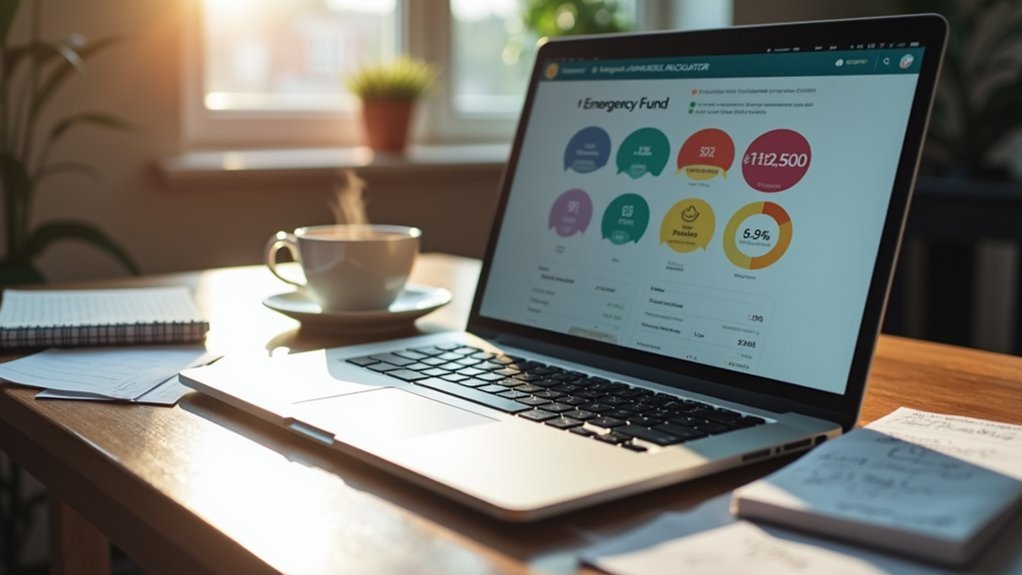Did you know that 63% of freelancers lack a sufficient emergency fund? As an independent professional, you’re likely maneuvering through financial uncertainties that traditional employees never encounter. Your income can fluctuate dramatically, making financial stability a complex challenge. Without a strategic approach to emergency savings, you’re exposing yourself to potential economic vulnerability. Understanding how specialized emergency fund calculators can transform your financial planning might be the key to building resilience in your freelance career. Want to learn how?
Key Takeaways
- Specialized calculators help freelancers determine personalized emergency fund targets by analyzing irregular income patterns and unique financial risks.
- Effective emergency fund calculators for freelancers consider factors like job insecurity, potential medical expenses, dependents, and geographic living costs.
- Digital tools enable precise calculation of recommended emergency savings, typically ranging from three to six months of essential expenses.
- Freelance-specific calculators transform complex financial planning into actionable strategies by accounting for income volatility and professional uncertainties.
- Dynamic emergency fund calculators provide a flexible framework for freelancers to systematically assess and adjust their financial safety net.
What Is an Emergency Fund for Freelancers?

Financial unpredictability looms large for freelancers, making an emergency fund not just a recommendation, but a critical survival strategy. Your emergency savings serve as a financial cushion designed to cover monthly living expenses during periods of unexpected income disruption. Typically, freelancers should aim to build a safety net that encompasses three to six months of essential expenses, protecting against potential client loss, project delays, or personal health challenges.
Unlike traditional employees, you’ll need a more robust emergency fund to compensate for the absence of employer benefits like paid sick leave or unemployment insurance. By methodically calculating your recurring expenses and consistently setting aside funds, you’ll create a strategic buffer that prevents relying on high-interest credit during financial uncertainties. This proactive approach guarantees your financial stability remains intact, even amid professional fluctuations.
Why Freelancers Need a Specialized Emergency Fund Calculator

Because freelance income ebbs and flows like an unpredictable tide, standard emergency fund calculators fall short of addressing the unique financial landscape professionals face.
A specialized calculator becomes essential for freelancers seeking thorough financial security. These tailored tools help you:
- Analyze complex income patterns with precision
- Calculate personalized savings targets based on irregular earnings
- Account for unique freelance-specific expenses
- Mitigate financial risks during contract gaps
Utilizing a dedicated emergency fund calculator enables you to input specific variables like fluctuating monthly expenses, equipment maintenance costs, and potential income variations. This methodical approach transforms abstract financial planning into a concrete strategy. By leveraging such a calculator, you’ll develop a nuanced understanding of your savings requirements, ensuring you’re prepared for unexpected financial setbacks and maintaining stability in your freelance career.
Key Factors Influencing Your Emergency Fund Size

When diving into emergency fund planning, freelancers must meticulously assess multiple interconnected variables that dynamically shape their financial safety net. Your emergency fund’s size hinges on critical factors like job insecurity, which demands a robust buffer against income volatility. The number of dependents in your household directly influences the fund’s magnitude, as does the potential for unexpected medical expenses or chronic health conditions. High debt levels necessitate a more substantial cushion to prevent additional financial strain during lean periods. Geographic considerations play a pivotal role, with living expenses in your area determining the required emergency fund depth. Strategically leveraging investment accounts while maintaining liquid reserves guarantees you’re prepared for unforeseen challenges, transforming financial uncertainty into a manageable risk landscape.
How to Determine Your Monthly Living Expenses

Understanding your precise monthly living expenses forms the cornerstone of crafting a robust emergency fund for freelancers. To accurately calculate your financial needs, follow a methodical approach:
- Track spending meticulously using bank statements or budgeting apps
- Categorize essential and discretionary expenses with precision
- Account for irregular expenses by prorating annual costs
- Calculate average monthly expenses across three to six months
Freelancers must adopt an analytical strategy to determine thorough coverage. Start by compiling all essential costs, including rent, utilities, groceries, transportation, and debt obligations. Include discretionary expenses, but prioritize fundamental financial requirements. By dividing annual expenses by twelve and analyzing spending patterns, you’ll develop a clear picture of your monthly living expenses. This systematic approach guarantees your emergency fund provides a reliable safety net during income fluctuations, protecting your financial stability with strategic planning.
Calculating Your Ideal Emergency Fund Target

While freelance income can be unpredictable, establishing a targeted emergency fund requires a strategic and precise calculation approach. You’ll want to save three to six months worth of expenses, with some experts recommending up to 12 months depending on your job loss risk. To calculate your ideal emergency fund, first itemize your essential monthly expenses, including rent, utilities, food, and business costs. Multiply this total by the number of months you’re targeting for coverage.
Consider your personal circumstances like income stability, industry volatility, and potential financial disruptions. Irregular freelance income makes a robust emergency fund vital. Regularly review and adjust your fund target to guarantee ongoing financial stability, accounting for changes in expenses and earning potential.
Best Places to Store Your Emergency Fund
Because effective emergency fund management hinges on strategic financial placement, freelancers must carefully evaluate storage options that balance accessibility, security, and growth potential.
- Prioritize high-yield savings accounts with competitive APYs from online banks
- Guarantee liquidity to cover unexpected expenses quickly
- Protect your money with FDIC-insured financial instruments
- Maximize potential returns without compromising emergency fund accessibility
When deciding where to keep your emergency funds, consider money market accounts and high-yield savings accounts that offer attractive interest rates. Online banks like Forbright Bank and Axos ONE® Savings provide attractive APYs around 4.25-4.66%, allowing your money to grow while remaining readily available. Avoid traditional checking accounts with minimal interest, as they won’t help your funds keep pace with potential expenses. Your goal is to maintain a balance between earning potential and immediate access, guaranteeing you’re financially prepared for any unexpected challenges in your freelance career.
Strategies for Building Your Emergency Fund
Freelancers maneuvering financial uncertainty must approach emergency fund construction with strategic precision and disciplined methodology. Establishing an emergency fund requires setting a clear initial savings goal, often starting at $500, and systematically increasing contributions. Automate savings by configuring recurring transfers to a high-yield savings account, ensuring consistent saving habits without manual intervention.
| Strategy | Action | Impact |
|---|---|---|
| Windfall Allocation | Deposit tax refunds/bonuses | Accelerate fund growth |
| Percentage Savings | Commit 10-15% of income | Build predictable cushion |
| Expense Tracking | Monitor monthly living expenses | Determine precise savings target |
| Periodic Review | Reassess every 3-6 months | Adapt to income fluctuations |
| Budget Optimization | Minimize discretionary spending | Maximize emergency fund potential |
Regularly review and adjust your strategies, recognizing that freelancers’ income can fluctuate dramatically, necessitating flexible financial planning.
Maintaining and Adjusting Your Emergency Fund Over Time
As your freelance career evolves, maintaining a robust emergency fund requires systematic, proactive management. Regular review and strategic adjustments are vital for financial security.
- Track monthly expenses using budgeting tools
- Automate contributions from freelance income
- Reassess emergency fund every six months
- Adjust savings to cover essential living expenses
Your emergency fund should dynamically reflect changing financial needs. Freelancers face irregular income streams, making a methodical approach to savings important. Calculate your fund based on current expenses, considering potential income fluctuations and professional changes. The goal is creating a flexible financial buffer that adapts to your evolving career landscape.
Navigating freelance finances demands a dynamic emergency fund that flexibly adapts to your evolving professional landscape.
Systematically evaluate your emergency fund’s alignment with your current financial situation, ensuring it provides adequate protection during unpredictable periods of freelance work.
Frequently Asked Questions
How Much Should Be in My Emergency Fund Calculator?
You’ll want 3-6 months of living expenses in your emergency fund, accounting for income fluctuations. Calculate essential costs, prioritize financial security, and build cash reserves strategically to manage unexpected expenses as a freelancer.
What Is the 3 6 9 Rule in Finance?
Like a financial safety net, the 3-6-9 rule guides your emergency savings strategy. You’ll save 3-9 months of expenses based on income stability, job market risks, and personal financial health, ensuring robust risk management during unexpected challenges.
Is $5000 Enough for an Emergency Fund?
$5,000 likely isn’t enough for a robust emergency fund. You’ll need to assess your monthly expenses, income variability, and potential risks. Consider building savings that cover 3-6 months of living costs to guarantee financial stability and resilience.
How to Calculate a Fully Funded Emergency Fund?
You’ll calculate your emergency fund by totaling monthly expenses, multiplying by 3-6 months, considering income variability and risk, then establishing targeted savings goals that protect against unexpected expenses while ensuring financial stability.
Conclusion
As a freelancer, you’re steering through financial waters where “saving for a rainy day” isn’t just a saying—it’s survival strategy. Your emergency fund calculator isn’t just a tool; it’s your financial lifeline. By methodically tracking expenses, anticipating income fluctuations, and consistently building reserves, you’ll transform uncertainty into stability. Stay disciplined, adjust your strategy regularly, and watch your financial resilience grow, ensuring you’re prepared for whatever professional challenges emerge.



